![]() 1st Battalion 22nd Infantry
1st Battalion 22nd Infantry ![]()
Captain Robert L. Hamilton
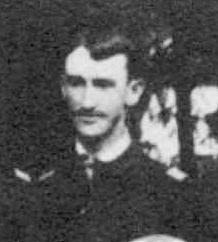
2nd Lieutenant Robert L. Hamilton
Photo taken when he was a brand new officer with the 22nd
Infantry.
National Archives photo 111-SC-98064
Robert Lee Hamilton was born in West Virginia on January 10, 1867.
He entered the United States
Military Academy at West Point on June 16, 1887 at the age of
twenty years and six months. His best subjects at the Academy
were Drill Regulations and
Ordnance and Gunnery, and his worst subjects were Mathematics and
French. He graduated
37 out of a class of 64 on June 12, 1891. Upon graduation he was
commissioned a 2nd Lieutenant
in the 22nd Infantry. He was one of two graduates from the
Military Academy that year
assigned to the 22nd Infantry, the other being Hanson E. Ely.
He joined Company D 22nd
Infantry at Fort Keogh, Montana on September 30, 1891. He served
with his Company
on the Northern Cheyenne Indian Reservation and at Camp Merritt,
Montana (established at the Lame Deer Agency)
from March 1 to June 1, 1892 where he was Camp Adjutant and Camp
Quartermaster. He was stationed at Fort Keogh
from June 5, 1892 to July 1, 1893 except for July 1892 when he
was with the Regiment suppressing mining riots in the
Coeur d'Alene region of Idaho.
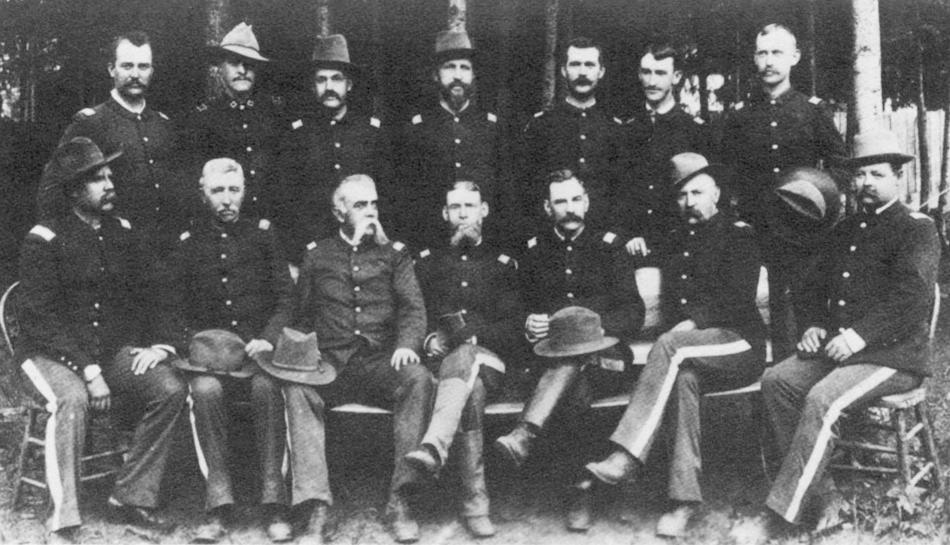
Officers of the 22nd and 14th Infantry
National Archives
records this as having been taken at Fort Keogh, Montana in
August 1892.
Second Lieutenant Robert L. Hamilton is standing back row second
from the right.
National Archives photo 111-SC-98064
Hamilton was detailed to the
Infantry and Cavalry School at Fort Leavenworth, Kansas on
September 1, 1893, being one
of two 22nd Infantry officers attending the School's class of
1894-1895, the other officer being 2nd Lieutenant Albert
C. Dalton. The essay written by Hamilton at the School to meet
his graduation requirements was entitled "Improvements
that have been made in Small Fire-arms and the consequent effect
upon Tactical Formations". He graduated from
the School on June 18, 1895 with the distinction of
"Distinguished Graduate". His record shows that he was
in Europe
for the next three months, starting on July 1, 1895, though
without specifying the reasons for being there. During the years
1894-1895 he was officially assigned to Company I 22nd Infantry.
Hamilton was at the Frankford
Arsenal in Philadephia, Pennsylvania for instruction in ordnance
work from October 1, 1895
to October 1, 1896. He rejoined the Regiment at Fort Crook,
Nebraska from November 1, 1896 to October 30, 1897. In 1897
he was assigned to Company H 22nd Infantry. He was then sent to
the Army's Engineer School at Willets Point, New York
for a course in submarine mining on November 1, 1897.
On January 26, 1898 Hamilton was promoted to 1st Lieutenant of the 5th Infantry.
When war with Spain broke out in
April 1898 Hamilton left the Engineer School and joined the 5th
Infantry at Tampa, Florida
on April 28. Assigned to Company K 5th Infantry he went with his
Company to Galveston, Texas on May 11. From June 5 to
July 19, 1898 Hamilton was detached from his Company and placed
in charge of the Torpedo Casemate at Galveston Harbor.
Learning that his Company was under orders to be sent to Puerto
Rico for combat duty, he requested and was granted
release from his duty at the Casemate to join his Company, then
in Camp at Tampa, where he joined them on July 21.
The orders for the 5th Infantry
were changed and Hamilton went with the Regiment to Santiago,
Cuba on August 20, 1898
where they were involved in occupation duties. While there
Hamilton was Acting Regimental Quartermaster, Post Exchange
Officer, officer in charge of prisoners and commanded Company K
5th Infantry. He was on sick leave from September 11
to November 22, 1898. On March 11, 1899 he became Acting Engineer
Officer, Department of Santiago
and Puerto Principe, Cuba.
On September 7, 1900 Hamilton
was promoted to Captain of the 22nd Infantry. He remained on
detached service with the
5th Infantry, travelling with them to the Philippines where he
rejoined the 22nd Infantry already on station there. He was
assigned to command of Company I 22nd Infantry on December 6,
1900. The official report of the 22nd Infantry for the
month of February 1901 made note that on February 22 and 23
Hamilton led a mounted detachment from the 22nd Infantry
in pursuit of bandits "to Bantog-Bobi, west of Rio Chico,
without success."
He was appointed Regimental
Commissary of the 22nd Infantry on May 17, 1901, leaving his
Company and joining Regimental
Headquarters at San Isidro on June 8. While at San Isidro he also
carried out the duties of Depot Commissary there. He was
relieved from duty as Regimental Commissary and appointed
Regimental Adjutant of the 22nd Infantry on September 8, 1901.
On that same date Hamilton was on detached service to Manila,
officially representing the 22nd Infantry for mourning and
memorial services related to the assassination and death of
President William McKinley lasting from September 8-21, 1901.
From September 21 to November
27, 1901 Hamilton was Telegraph Instructor for the Department of
the Philippines. He was
then on detached service from November 27 to December 7, 1901
attending a session of a General Courts Martial in Malabon
in the Philippines. As the 22nd Infantry left the Philippines he
was enroute to the United States from January 31 to February 25,
1902.
Hamilton was the Regimental
Adjutant and Recruiting Officer of the 22nd Infantry at Fort
Crook, Nebraska from March 11 to
May 29, 1902. He then took leave from May 29 to July 29, 1902. He
was with the Regiment at the maneuvers at Fort Riley,
Kansas from September 5 to October 2 when he was admitted sick
into the Field Hospital at Fort Riley. He stayed in the
hospital until October 6 and was on detached service at Fort
Crook from October 11 - 22. On October 22 he resumed
his duties as Adjutant and Recruiting Officer.
COL Henry Wygant,
Commanding Officer 22nd Infantry CPT Robert L. Hamilton, Adjutant (on the right) Photo taken at Fort Crook, Nebraska 1903 Photo from the Omaha
Daily Bee, October 11, 1903 |
|
Hamilton went with the Regiment
to St. Louis, Missouri for the dedication of the Louisiana
Purchase Exposition
April 28 to May 1, 1903 then took leave to May 5. He became the
Signal Officer at Fort Crook on May 19, 1903.
He took leave again until July 31 and resumed his duties as
Regimental Adjutant, Post Adjutant, Recruiting Officer
and Signal Officer at Fort Crook on August 1. He again took leave
and returned to the post on October 11. He was
enroute from Fort Crook to San Francisco October 21-25 and was at
the Presidio in San Francisco from October 25-31.
Hamilton sailed with the 22nd
Infantry to the Philippines on October 31, 1903 onboard the
Transport Sheridan,
arriving in Manila on November 28, 1903. He was enroute from
Manila to Camp Marahui on the island of Mindanao
from December 1-6. In addition to his duties as Regimental
Adjutant, at Camp Marahui he became the Camp Adjutant
and Recruiting Officer. He took part in the engagement with
hostile forces at Ramaien on Lake Lanao, on January 22, 1904,
when the four Companies of 1st Battalion under command of Major
J.S. Parke moved across the lake by boat and
engaged Moro forces at the mouth of the Ramaien River. Sometime
after this engagement Hamilton was sent on detached
service to Zamboanga until March 2. He returned to Zamboanga on
detached service again, this time as a witness in a
General Courts Martial from March 16 to 29.
Hamilton left Camp Marahui on
April 7, 1904 bound for the United States. Once back in the
States he was granted leave
for one month which was then extended for another 15 days. On his
way back to the Philippines he was assigned to duty
involving recruits on June 24. He sailed from San Francisco on
July 1 and arrived in Manila on July 31, 1904. He rejoined
the Regiment on August 20. On August 21 he was detailed as Post
Adjutant and Recruiting Officer at Camp Marahui.
From October 22-25, 1904
Hamilton commanded 2nd Battalion 22nd Infantry in an engagement
against the Sultan of Oato
near Lake Lanao on the island of Mindanao. His Battalion in
concert with Troop F of the 14th Cavalry, a Provisional Company
of the 23rd Infantry and a battery of the 17th Field Artillery
made an envelopment of the Sultan's territory by land and by boat
across Lake Lanao. The entire force was commanded by Lt. Colonel
Henry E. Robinson of the 22nd Infantry. On the morning
of October 24 Hamilton landed his Battalion in boats under fire
from the Moros and assaulted and captured several small forts.
Before the assault on the final fort the artillery joined up with
the Battalion and the battery fired on the fort for thirty
minutes
resulting in the Sultan's surrender. Hamilton's loss for his
Battalion was one officer and one enlisted man wounded. In the
report
of Colonel Henry Wygant, Commander of the 22nd Infantry and
Commanding Officer of Camp Marahui concerning this
engagement Hamilton was commended "...for energy and
judgment in the landing of his command. To his tireless energy
was due the success of troops in capturing the first Cotta (fort)
before the arrival of the artillery."
It was on this deployment to the
Philippines during 1904 that Hamilton, as Regimental Adjutant,
compiled the history of the
22nd Infantry Regiment, published in Manila by E.C. McCullough
& Co. He wrote the following dedication in the front of
the book:
To the regiment's
"Killed in Battle" this recital of
unworthier soldiering is dedicated
|
The Preface page of the
official At the bottom of the page is
Hamilton's From the webmaster's collection |
Hamilton took leave for two days
January 1 and 2, 1905. He was sick in quarters at Camp Keithley
on the island of Mindanao
from April 14 to May 5, 1905. He was ordered to Manila for
treatment in the Division Hospital on May 5. His illness was
severe
enough to have him ordered sent back to the United States for
hospitalization. On May 16 he was relieved of his duties as
Regimental Adjutant after serving in that position for four
years. On May 17 he was relieved from his responsibilities as
Post Adjutant and Recruiting Officer at Camp Keithley and on May
22 he sailed aboard the Transport Thomas bound for
the United States. Upon reaching the States he was admitted to
the U.S. Army General Hospital at the Presidio at San Francisco
where he remained as a patient for several months.
While still sick in hospital he
was officially assigned to command of Company B 22nd Infantry,
then on their way back from the
Philippines. He was released from the hospital on December 16,
1905 but remained sick in his quarters at Fort McDowell at
San Francisco until January 26, 1906. While there his command was
officially transferred from Company B to Company L on
January 15, 1906. He was ordered for treatment to the Army &
Navy General Hospital in Hot Springs, Arkansas, leaving
Fort McDowell on January 26, 1906. On that date Hamilton was
officially recorded as having left the Regiment. His official
status
became one of being on leave with a surgeon's certificate of
disability.
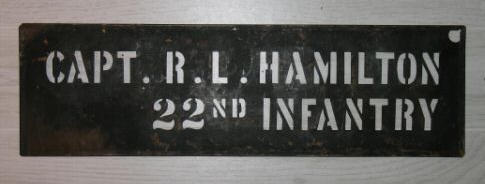
This metal stencil used
by Captain Robert L. Hamilton to mark his baggage and personal
possessions was offered for sale on Ebay some years ago
On September 13, 1906 Hamilton's
leave was extended for two months on "account of
sickness." On November 5 his Leave
Of Absence was extended for another six months for the same
reason. He rejoined the 22nd Infantry in San Francisco on
April 20, 1907. He commanded a Company for two days, April 21-22
then on April 23 was sick in his quarters until May 3.
He was admitted to the U.S. Army General Hospital at the Presidio
of San Francisco from May 27 to June 13, at which time
he returned to his quarters where he was sick in quarters until
June 24.
On June 24, 1907 Robert L.
Hamilton was retired from the Army with the rank of Captain on
account of disability incident to the
Service. He retired to his residence at Omaha, Nebraska. (On June
13, 1916 his retirement was increased to the rank of Major
with disability contracted in the line of duty.) He had served
twenty years in the Army with approximately sixteen and a half of
those years in the 22nd Infantry.
On March 5, 1914 Robert L.
Hamilton (U.S.Army Retired) was detailed as Colonel of Infantry
on the General Staff of the Nebraska National Guard. He was
carried on the record as a U.S. Army Officer
detailed to the National Guard.
Col. Hamilton was the senior
instructor during combat training held by the 4th Infantry
Regiment of the Nebraska National Guard
at Camp L.D. Richards at Fremont, Nebraska August 10-16, 1915.
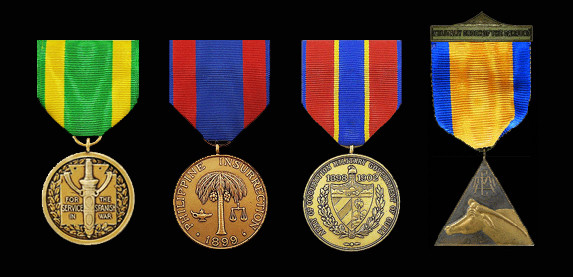
Decorations of Robert L.
Hamilton:
Left to right:
Spanish War Service Medal, Philippine Campaign Medal, Cuban
Occupation Medal, Order of the Carabao
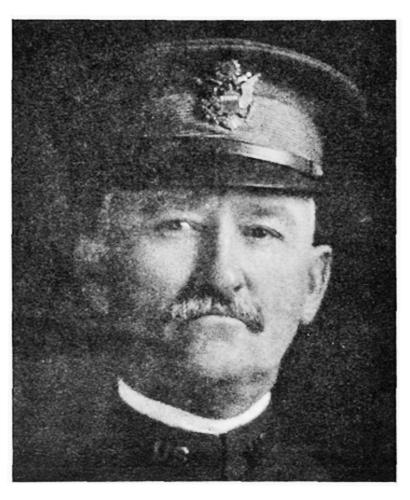
Undated photo of Robert Hamilton later in his career
Robert Lee Hamilton
NO. 3421 CLASS OF 1891
DIED APRIL 16, 1952, AT SPOKANE, WASHINGTON, AGED 85 TEARS.
WE all reported at the Academy
in the sunny days of 1887. These were days of prosperity
throughout the land and eminently peaceful.
A few turbulent Indians infested our frontier; but otherwise all
seemed calm. We were the earliest class to report with every one
of the class
born after the close of the War Between the States.
It appears we began to know all
the class after we returned from plebe camp and began the
academic work. Hamilton was always kind,
patient, and a good working member of our '91 group.
Many of us never knew where he
acquired the nickname of "Fake". Nicknames are
considered a sign of good fellowship, and names
that held for a lifetime were often acquired from some very
slight circumstance. He was decidedly the opposite of a fake; no
man could be
less a fake than he. He was always just the man he appeared to
be. With other Hamiltons in the Corps, a nickname was acquired
more readily
and stayed more fixedly in order to distinguish him from other
Hamiltons. A majority of class members had nicknames and almost
all
originated on some joke on the recipient. Our first year had a
bright spot in the visit of Henry Irving and Ellen Terry, the
best actors
of the time. They kindly came to West Point with their troupe and
gave the Corps the play "The Merchant of Venice" One
event that
marked this in our memory was the great blizzard of 1888. This
was the historic storm that was important enough to be featured
in
the newspapers on March 1948, sixty years afterward. There was
just time to shovel the snow away and make the roads passable
for the visit of these famous actors. Many of Shakespeare's plays
have a clown and the clown in this play gave a lasting
impression,
not eclipsed by the high talent of the leading actors.
One Saturday evening Mark Twain gave a reading before the Corps. He was one of the greatest humorists of all time.
General Sherman spoke a number
of times during our four years of cadetship. He had an offhand
way of speaking and his addresses
with a moderate amount of humor have been to many of us a
pleasant recollection of cadet days. The members of our class
were
hoping that General Sherman would hand us our diplomas, but
destiny decreed otherwise. In March of graduation year,
we marched in New York at his funeral.
In all the pleasant events of
the four years, Cadet Hamilton took a lively interest, and
maintained the same kindly manner which was
his natural way. Hamilton roomed with Fleming and this was a
combination of genial associates.
But finally the four years of
cadetship drew to a close. Honorable Redfield Proctor, Secretary
of War, handed us our diplomas;
and soon we were in citizen clothes, walking down the hill to the
boat or the railroad station. The play we saw in New York
that evening was one in which DeWolf Hopper and Delia Fox were
the principal actors. As with other classes, graduation
brought about an entire change in the surrounding circumstances
with us—the former cadets.
The writer saw Hamilton as an
officer when we were on duty in the mining strike in Idaho in
1892. In these disorders the
Governor of Idaho saw that his power was unable to keep order by
depending on the State alone; he requested the President
in Washington to send troops. This is where the Regular Army came
into the scene. This was in the Coeur d'Alene district
and some of the troops during this trouble were encamped at
Wallace, Idaho.
When the Regulars arrived, the
people seemed to have been in a state of terror. There had been
severe clashes with the nonunion men,
and many in the town seemed very wary about expressing
themselves.
After the regiment had been
encamped a few days, the active work began. A company marched
down into town, and with a
civilian to identify the culprits, one hundred and fifty men were
arrested and put in the center of the company, which was the
guard.
Later the company marched back to camp and the prisoners were put
in a place of detention. This was a house and a good sized
new barn. The prisoners were confined in these buildings during
the night and In the day they were allowed the use of the large
yard.
Sentinels were placed around this enclosure with orders, of
course, to shoot any prisoner attempting to cross the sentinel
post.
The climate varied much during
each twenty-four hours. At midday the thermometer ran high and
those not on duty found
the shade of the tents very welcome. The sun set behind the high
mountain range at 4:00 P.M., and in a few minutes we could
feel the cool air pouring down from the high hills. By eight in
the evening we were in overcoats standing around the camp fire
to keep warm. But altogether it was a fairly good summer climate.
This work lasted more than two
months. Toward the end of this time, the military authorities
received orders to send the prisoners
with a detachment of soldiers to appear before a local court,
which fixed the bail for each prisoner. The amount of the bail
differed for various individuals. Two prisoners were placed at
very high bail, and the military authorities were worried because
these charged with high crime were kept with the others, whose
bail was light.
Finally, all the prisoners had
been bailed out or turned over to the civil magistrates. Then the
soldiers had a payday, so they
could settle their accounts with the storekeepers. Then the
individual regiments received orders to return to their
respective garrisons.
At this time commendation came from an unexpected quarter. A
number of the former prisoners took the trouble to come back
and tell the officers that they knew the regiments were under
orders, and considering this, they thought the regiments carried
out
their orders with fairness and efficient decision. This is no
attempt to give the words of the former prisoners, but this is
the substance
of what they said.
Whether the occasion needed
tact, sternness, or discipline, Lieutenant Hamilton was there and
his record was the best.
This occasion brought a number of regiments together and we met
some for the first time since graduation. General Ely
was there and also General Bradley; all four of us, one year out
from graduation, and all Second Lieutenants at the time.
The following data is taken from
a summary of events of Major Hamilton's life, some being taken
from sentences in
Cullum's Register of Graduates: Robert Lee Hamilton:
born in West Virginia; appointed from West Virginia; before
entering
West Point he attended Randolph Military School at Huttonsville
in his native State; he married Bess Iler at Omaha,
Nebraska; he met his future wife when he was stationed at Fort
Crook, Nebraska.
His first station was at Fort
Keogh, Montana; at Infantry and Cavalry School at Leavenworth,
1893 to 1895, distinguished graduate;
in Europe for three months after finishing course at Leavenworth;
at Frankford Arsenal for instruction in ordnance work,
October 1, 1895 to October 1, 1896; with regiment at Fort Crook.
November 1, 1896 to October 30, 1897; at Willets Point, 1897;
joined regiment at Tampa. April 28, 1898; promoted to captain
September 7, 1900; arrived in Philippines, commanding Company
"I",
December 6. 1900; during this time he was appointed to many
details as adjutant, commissary, quartermaster, recruiting
officer,
signal officer; these details show that he was an efficient
officer, detailed by commanding officers who wished reliable
work;
for his second tour of the Philippines on transport Sheridan,
October 31st to November 28, 1903; at engagement at Romaien
River,
Mindanao, January 22. 1904; retired as a captain June 24, 1907
for disability incident to the Service.
Having recorded this data it seems well to resume the story in narrative form.
At the outbreak of the Spanish
War, First Lieutenant Hamilton was for a time stationed at Tampa,
Florida. A large number of troops
were there and we met many we had not seen since '91. Soon First
Lieutenant Hamilton received orders to take station at Galveston,
Texas, where he was in charge of the Torpedo Casement, Galveston
Harbor. On August 20th 1898 he went on duty in Cuba
where yellow fever took a decided toll in the regiment.
In August and September most of
us with the regiments were on duty at the camp at Montauk Point,
Long Island, where one by one
the Individual regiments received orders to break camp and
entrain for regular garrison.
Returning from a month's leave
of absence in the United States, during his second tour in the
Philippines, Captain Hamilton sailed
from San Francisco July 1, 1904 and arrived at Manila July 31st.
In October he commanded a battalion of the regiment on an
expedition against the Sultan of Dato; he was commended in the
report of the Commanding Officer of Camp Marahui on this
expedition "for energy and judgment in the landing of his
command. To his tireless energy was due the success of troops
in capturing the first Cotta."
In 1907 came the break mentally
and physically, that ended his active career. Before this, those
who knew him, looked forward
to places of high rank and important duties for him. Such as
these were the promise of early manhood, but the only answer is,
"Such was not to be".
Thus ended the active part of
his military career, and of him it can be truly said: "They
also serve who only stand and wait"
a saying of the poet, Milton, which is well deserved. Some
critics have said this verse is not a general rule and applies
only
in rare cases; it most certainly applies in the case of Robert
Lee Hamilton. When the clouds of mental and physical sickness
gathered, it would seem that he received more than his share of
misfortune.
He was promoted to major on the
retired list in 1916. He was an invalid for a very long time,
although his life passed well beyond
the four score mark. In 1951 Sorley, our Class President, on
receiving a letter from him who had had such a very long
sickness,
was pleased with the excellent penmanship and the calm serene
view of general affairs expressed in the letter.
He passed away on April 16, 1952
at his residence in Spokane, Washington. He was born at
Huttonsville, West Virginia,
on January 10, 1867. Surviving are his wife, Bess Iler Hamilton,
and his children, Lee Hamilton Nielson, Peter Iler Hamilton,
and Edith Hamilton Haines. There are six grandchildren.
One who knew him well has
written, "There never lived a finer gentleman. Every one who
knew him was very fond of him
and he was an inspiration to us all. I wish I had the power of
expression to tell you how much the Service and West Point
meant to him, 'Duty, Honor Country', was so much a part of his
being"
And so the Class sets its seal
of approval on the attention to duty, on the patience in long
sickness, and on the life work
of Robert Hamilton. At one of our "Hundred days to
June" entertainments, some poetry was read, which became a
classic
in our time in the Corps of Cadets. And so for a summation of his
life on earth we quote a line from this well received writing
by one of the cadets:
"He did his level best"
—A, B. D.
From ASSEMBLY magazine Volume XI Number 4 January 1953
Robert L. Hamilton died at Spokane, Washington on April 16, 1952.
Burial:
Arlington National Cemetery
Arlington
Arlington County
Virginia, USA
Plot: Section 3 Site 2052-A-1
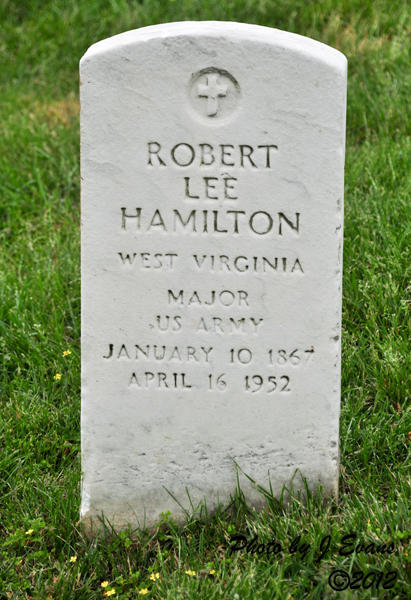
Grave marker for Robert L. Hamilton
Photo by John Evans from the Find A Grave website
Sources:
BIOGRAPHICAL REGISTER of the Officers and
Graduates of the U.S. Military Academy at West Point, New York
by Brevet-Major-General George W. Cullum, SUPPLEMENT VOLUME IV,
Riverside Press, Cambridge 1901
BIOGRAPHICAL REGISTER of the Officers and
Graduates of the U.S. Military Academy at West Point, New York
by Brevet-Major-General George W. Cullum, SUPPLEMENT VOLUME V,
Seeman & Peters, Saginaw. Mich.1910
BIOGRAPHICAL REGISTER of the Officers and
Graduates of the U.S. Military Academy at West Point, New York
by Brevet-Major-General George W. Cullum, SUPPLEMENT VOLUME VI-A,
Seeman & Peters, Saginaw. Mich.1920
ASSEMBLY Volume XI Number 4 January 1953, West Point Alumni Foundation, New York, New York
Official U.S. Army Registers 1892-1916
Annual Reports of the War Department for the
Fiscal Year Ended June 30, 1906 VOLUME I
Government Printing Office, Washington D.C. 1906
22nd Infantry Regimental History published 1904
Biennial Report of the Adjutant General of the State of Nebraska for 1915-1916
Home | Photos | Battles & History | Current |
Rosters & Reports | Medal of Honor | Killed
in Action |
Personnel Locator | Commanders | Station
List | Campaigns |
Honors | Insignia & Memorabilia | 4-42
Artillery | Taps |
What's New | Editorial | Links |